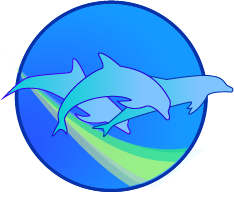It was ecstatic moments with an autistic boy, fins rising around us, which fully opened a new door for me.
I wanted a miracle.
A teacher of children with autism introduced me to a six-year-old pre-verbal boy. He seemed nearly impossible to work with, often yelling loudly in protest and was difficult for me to understand. His mom had never heard him say a clear word and his teacher had once heard him say “turn on” in reference to the TV in the classroom. Otherwise, sessions to elicit speech were not going well.
I brought swim masks to class one day and some of the kids tried them on. Nate allowed a mask to be placed on his face, but quickly pulled it off, protesting with yells.
Another day, Nate’s program assistant, John, met me, along with Nate and his mom, at a protected tidal pool. I brought a large innertube with a cloth floor on it to this shallow lagoon where Nate enjoyed playing. He climbed in the inner tube and let me swing him around before rolling out to wade and splash in the water. In this way, he would be familiar with one element of our dolphin trip—the innertube would be used on the ocean as well.
Nate seemed the least likely subject for a movie, crying out and grimacing at any interruption in his desires or new requests. Children with autism tend to prefer the known, repetition of familiar schedules and activities. How would Nate respond to a totally new environment? His teacher and mom agreed to meet me at the harbor in Kona. We would go out on a four-hour boat trip to find and be with dolphins.
Nate enjoys rides in the car. His mom followed me over Saddle Road early the morning of our boat excursion. At the marina, Nate pulled away from his mom and the teacher who would attend him during the trip. We decided his mom should stay on shore to allow him the opportunity to more fully experience the unusual day without the possibility of clinging to familiarity. Nate screamed and balked during the boat orientation time. I asked his mom what she expected from the day with dolphins. “A miracle,” she replied. “I believe the dolphins can bring about a miracle and Nate will begin to talk.” Wow! Her high expectations overwhelmed me! While I held the same high intention, I admired her utter conviction. Having heard about dolphins helping to teach children with special needs, she was convinced the dolphins had a power to heal and could help her child overcome his lack of speech.
A miracle. We set sail for the life change of a miracle.
We launched the big, yellow inflatable boat from the trailer into the marina and Nate was allowed on. From the time Nate stepped aboard, to the time he left, he enjoyed himself. Squealing in delight, with delicious intent, Nate ran from side to side, leaning over the edges. He jumped up and down in the bow on the waves. Nate dragged a flotation “noodle” in the water alongside the boat, never releasing it to the wake. He was content, excited, and discovering new sensations. Nate was completely out of his routine, in a new situation, faced with experiences and choices he had never encountered. Yet he was totally “in his element”!
The captain found dolphins milling in a bay. The dolphins looped around the boat, resting and playing, as we drifted in neutral. Because the dolphins had already spread out and relaxed in the bay, they didn’t ride the bow or jump around the boat as they often do when we find them traveling the coastline. Nate had no time to get a good look at them up close. Perched in the middle of the bay, everyone else got into the water and swam off with dolphins.
Nate was now anxious to get into the water. I brought out the familiar inner tube and Nate let himself be dropped over the side, about 3 feet, and into the tube. He happily sat in the big blue and green innertube as I pulled him away from the boat.
“There are dolphins,” I said and pointed. Nate was enjoying the water. He was happy as I swung him around.
“There they are,” I said and pointed as fins popped up. Nate wanted to get into the water and slid over the side of the tube and into my arms in the deep, blue ocean. He had a small life vest on and I used a noodle between my arms for extra floatation. I let go of the tube and it floated nearby. We were buoyant enough to keep our heads in the air very easily. I had my fins and mask on but my mask stayed on top of my head the entire time. Nate and I hugged each other, his legs wrapped around me, and played in circles, bobbing on the small swells. Once in awhile, he pinched my arms in an anxious excitement. When he would get nervous, I would hold him tight and go in around in circles. He got very excited, seemingly overjoyed, in short bursts. The whole dolphin pod swept through us. Masses of fins emerged alongside us.
“Here are the dolphins,” I said quietly. “They’re all around us. See them?” I ask, turning us so he can look at the fins go by. He tucked his head between us, and tightened up, squeezing me. The dolphins were below and around us.
I felt a sense of joy raise and raise, heightening inside me, bursting in ecstasy! Nate squeezed harder, grimacing intently. I felt we were both in a state of pure joy, reveling in the presence of a hundred dolphins swinging around us. Without a mask on, I had little visual contact with the dolphins, no cues as to what they were doing, no way to respond in body language to their presence and whistling. Instead, I was completely caught up in sensation at the center of a vortex, in an ecstatic state with another person while surrounded by dolphins. In this newness, I had only my intuition, feelings, trust, and a “meta-viewpoint” to act on. I let go of any behavior and just was. I joined with Nate and we seemed to become a small tight ball of joy in the middle of the ocean, in a visual circle of bright yellow, orange, blue, and green. We were all there was and yet we were in an extraordinary setting with extraordinary inputs and responses. We were one and we were everything in which we were immersed and we were one.
I had a moment of absolute harmony with the work I was allowing to happen. Allowing Nate to experience whatever he did, granted me the opportunity to join him in his high level of excitement. Just an experience with the dolphins was nowhere near as exciting. I was thrown out through the top of my head! Dolphins often lead to euphoria, but a joint ecstasy was a different state than I previously experienced with another person with the dolphins. Energy streamed through our bodies and up and out of us.
As the dolphins moved on past us, we settled down again and found ourselves, floating alone, not far from the tube and 100 yards or so from the boat. As I kicked us towards the boat, Nate wanted back into the tube. I was too exhausted to do much to push him in and the large tube was unbalanced without anyone holding down the other side. Fortunately, someone jumped in and grabbed the other side of the tube so Nate could slide in. From there he was lifted back onto the boat.
I took some time alone in the water, stretching out and floating relaxed on the surface. I was exhausted, but not extinguished! I passed through a doorway and a light had come on. In the moments of ecstasy, I thought, “This is what I should do. This has meaning. There’s something happening here that I didn’t foresee or create. I allowed. I experienced, jointly, the joy of another who was bouncing off my own joy. The joy rose, bouncing between us. We stimulated each other, completely allowing, with ease, the joy to build.
I am used to joy in the presence of dolphins. I appreciate new feelings, experiences, and responses with dolphins in a free flow of interactions. I was used to a lack of self-consciousness in the immense privacy of the ocean. I surrendered and allowed, in trust and acceptance and gratitude and happiness, the joy to build. Now I felt as if I fulfilled my mission as a naturalist, a facilitator in wild dolphin therapy for a preverbal boy with autism. I felt right in that position, capable where there was no training, appropriate without instruction. I had entered naпve and curious and excited with incredible yet unexpected success. We did what we came to do, although we hadn’t a plan.
The boat ride home continued the fun and adventure. Nate loved the boat! On the return trip, he loved going fast and jumping up and down. As we glided through the marina, Nate’s mom called from the shore. Nate looked up into his mom’s eyes, recognizing her from a distance. His mom knew right then that something had changed. Nate was making eye contact. He saw far beyond his immediate site. He had experienced many new activities, not knowing what would happen next. Familiarity and schedule were replaced by an entirely new day with few touchstones he knew.
At home that night, after the trip, passing by his personal assistant’s home, he repeated clearly to his mom “John. John.” For the first time, clearly and in context, his mom heard him speak. Later, to his uncle, he said “Hi Dan.” His mom said it was the first time he really addressed someone. He brought his mom his swimsuit before bedtime, indicating he would like to get in the water again.
The world changed a little for Nate and his mom. The boy burst through a doorway. Nature. The boat. The ocean. The dolphins. The ecstasy. The therapist’s initiation. The mother’s hope. Our vision and intent. An amazing change. A miracle.
Nate spoke every week after that day. His mom heard him clear and true. Just two days later at a session on the beach, with dolphins in the distance, I heard Nate too. “Way. Way,” he said quietly and clearly, looking at the two paths leading to the water. “Which way do you want to go? Either way is good,” I had said. “Way. Way.”
My 21-year old daughter, Harmony, was with us as a swim assistant. Pulling Nate in the inner tube across the bay with dolphins, I pointed to the Spinner dolphins jumping and said, “Tell me if you see the dolphins. Say, ‘I see them!’” “Seez ‘em. Seez ‘em,” he enunciated with his head down in the tube. Harmony and I looked at each other from either side of the tube, grinning with wonder in our eyes as we listened to the dolphin’s whistle.
Return from Autism and Dolphins to the Wild Dolphin Swims Hawaii home page



















 I
I







